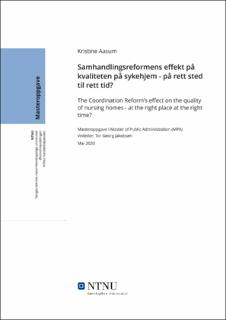| dc.contributor.advisor | Jakobsen, Tor Georg | |
| dc.contributor.author | Aasum, Kristine | |
| dc.date.accessioned | 2021-09-14T17:14:24Z | |
| dc.date.available | 2021-09-14T17:14:24Z | |
| dc.date.issued | 2020 | |
| dc.identifier | no.ntnu:inspera:55684094:9577851 | |
| dc.identifier.uri | https://hdl.handle.net/11250/2777131 | |
| dc.description.abstract | Den 1. januar 2012 ble samhandlingsreformen innført i Norge, noe som førte til forandringer for helse- og omsorgstjenestene. Samhandlingsreformen skulle være en reforme som skulle gi innbyggerne «rett behandling -på rett sted- til rett tid». En konsekvens av reformen var at en større del av pasientbehandlingen ble overtatt av kommunene, fordi pasientene skulle få den hjelpen de trenger, nært der de bor. I denne oppgaven undersøker jeg hvordan brukerne av kommunale omsorgstjenester opplever kvaliteten på tjenestene etter innføringen av samhandlingsreformen, og det gjør jeg i lys av implementeringsteori og organisasjonsteori. Jeg har tatt utgangspunkt i brukernes opplevelse av kvaliteten på sykehjem i kommunene, og har målt over tid, før og etter innføringen av samhandlingsreformen. Gjennom undersøkelsen har jeg forsøkt å svare på problemstillingen:
Hvordan har samhandlingsreformen påvirket brukernes opplevelse av kvaliteten på kommunale tjenester?
Undersøkelsen er gjennomført ved bruk av kvantitativ metode, og målingene jeg har benyttet meg av baserer seg på gjennomsnittstall fra innbyggerundersøkelsene utført over fire forskjellige år. Jeg benyttet meg av fem kategorier fra innbyggerundersøkelsen når jeg skulle finne svar på problemstillingen.
Studien viser at brukerne av kommunale helse- og omsorgstjenester, herunder sykehjem, i mindre grad er fornøyde med kvaliteten på tjenestene noen år etter at samhandlingsreformen ble satt i verk. I diskusjonsdelen i denne oppgaven, finner jeg også at samhandlingsreformen har endret arbeidshverdagen til helsepersonell som jobber på sykehjem. Behovet for å styrke kompetanse og grunnbemanning på sykehjem virker å være stort. Samhandling mellom sykehus og kommuner virker heller ikke å være godt nok, og helsepersonell i kommunene lider under tidspress som en følge av de nye arbeidsoppgavene.
Med bakgrunn i disse utviklingstrekkene virker det å være sannsynlig at det er en sammenheng mellom helsepersonells opplevelse av effekten av samhandlingsreformen, og målingene fra innbyggerundersøkelsene som viser at brukerne er mindre fornøyde med tjenestene de mottar, noen år etter at samhandlingsreformen ble innført. | |
| dc.description.abstract | January the 1st, 2012, the Coordination Reform was introduced in Norway, which led to changes for the entire national health service. The Coordination Reform was meant to give the citizens “right treatment – at the right location – at the right time”. A consequence of the reform was that a larger part of the treatment of the patients in the health-care system was taken over by the municipalities. The reason was that the patients were supposed to receive the treatment they needed near where they live. In this master’s thesis I will investigate how the patients experience the quality of the health services offered in the municipalities, after the introduction of the Coordination Reform. I will do so from a perspective of the organization-theory and implement-theory. This study’s starting point is the patients experience of the quality of the nursing homes in the municipalities. I have measured over time, before and after the introduction of the Coordinating Reform. The thesis’s statement has been to investigate how the Coordination Reform has influenced the patients experience of the quality of the services given in the municipalities.
This study is carried out by using a quantitative method. To measure I have been using average numbers from a study of citizens. The measures took place on four different years. There are five categories I’ve been using to investigate the thesis statement.
The findings in this investigation, shows that the patients using the health- and care services in nursing homes, are less satisfied with the quality of the services a few years after the introduction of the Coordination Reform. In the discussion-section of this thesis, I also find that the Coordination Reform has changed the health carers everyday life at work, for those working at nursing homes. It seems that the needs to strengthen the competence and the number of workforces at nursing homes are large. The interaction and coordination between the hospitals and the municipalities are still not good enough, and the caregivers working in the municipalities are suffering under time pressure when taking over new tasks.
Because of those developments, there will most likely be a relation between the health-care workers experiences after the introduction of the Coordination Reform, and the measures from the study of the citizens, showing that the patients are less satisfied with the services they receive a few years after the introduction of the Coordination Reform. | |
| dc.language | | |
| dc.publisher | NTNU | |
| dc.title | Samhandlingsreformens effekt på kvaliteten på sykehjem - på rett sted til rett tid? | |
| dc.type | Master thesis | |
